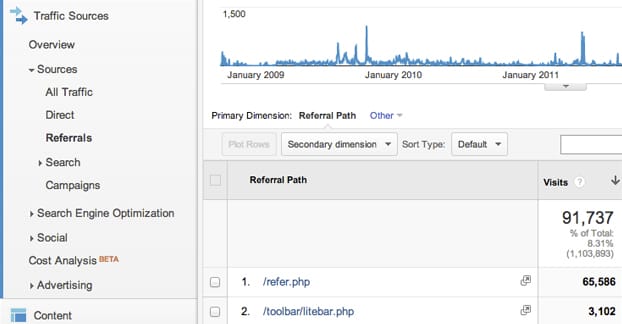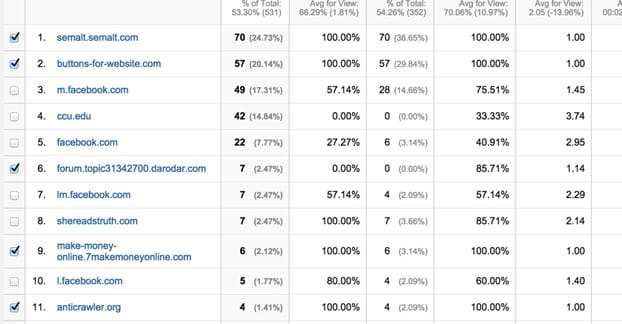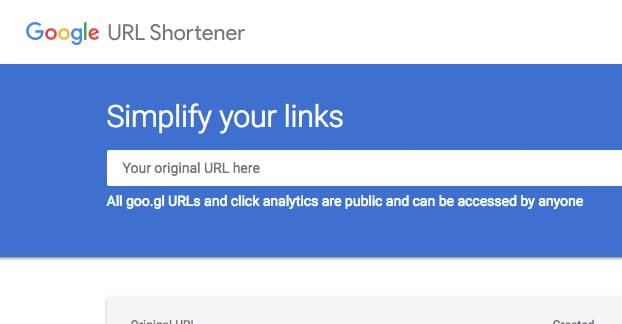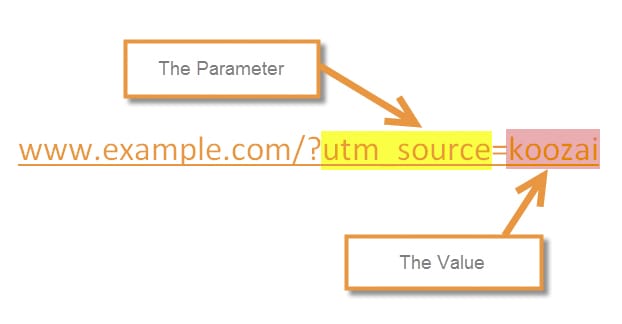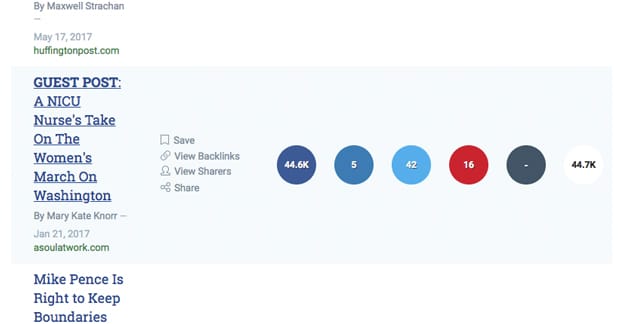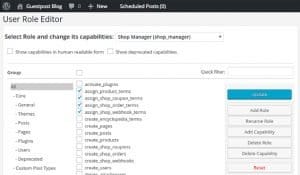I have very serious thoughts about the viability of guest blogging with an emphasis on traffic generation, some of which I’ve posted on this site before. However, it’s still one of the driving motivations for hundreds of marketers getting into guest posting, so it’s a valid enough pursuit. Some traffic is better than no traffic, and even if you’re approaching guest blogging from the wrong angle, it’s still better to do it than not. The ends of getting people to guest post are all that matter; I don’t really care why you do it. I just think you should.
That said, I’m going to take the time here to explain some ways you can track traffic from your guest posting efforts, to try to figure out what your return will be. Just keep in mind that it’s likely to be less than you think, potentially far more so than you would expect.
1. Check Referred Traffic in Google Analytics
The first and most obvious way to track traffic is to use an analytics suite. I generally just recommend Google Analytics. It might not be the most robust analytics suite, but it’s easy to set up, it gives you relevant data, and it’s free. You can’t really scoff at that.
That said, pretty much any analytics suite is going to be able to give you the information you’re looking for. I’m just giving instructions for Google Analytics because it’s by far the most common and generally applicable. If you’re using a different analytics program, feel free to ask in the comments; I or someone else might be able to help you set up referral tracking.
In Google Analytics, you want to look on the left hand sidebar, where all of the main categories are listed. You’ll Audience, Real-Time, Behavior, and so forth. The one you’re looking for here is Acquisition.
When you click to expand the Acquisition section, one of the subsections you’ll see on that sidebar is All Traffic. Click on that to further expand it into sub-subsections, and click on the Referrals link. This will finally change the right pane into data.
By default the traffic you see is sorted by referral source. For example, you might see all of the hits sent to your side from Google.com, from YouTube.com, from Reddit.com, and so on. This is useful, but doesn’t tell you much about guest posts. If you only have one link from a given domain, and it’s in the guest post, then that’s fine. However, if one guest post links to two pages on your site, they will be lumped together, and if the site has linked to you several times in the past, those will be lumped together as well.
Above the spreadsheet but below the graph, you see Primary Dimension. It’s currently set to Source by default, but you can click “landing page” to change to the data we really want to see. This will show you a list of landing pages on your site, and the hits referred to them. This is a bit better, but it still doesn’t differentiate regular traffic from traffic originating at that guest post. For that, you need to find the specific landing page and click the link in the spreadsheet.
Here, you need to add a secondary dimension to get the data you really want. Up above the chart again, click to add a secondary dimension. In the small box that appears, either type in Source, or click acquisition and click Source. Once you click this, then you’ll finally see your data. You’ll see different pages that send traffic to your landing page. Look for the URL of the guest post, and you should be able to find what you need.
It’s worth noting here that if you have a significantly large site and have a lot of pages to navigate through, it can be worthwhile to use the advanced search to filter data to make it easier to find what you’re looking for. Smaller sites will be able to simply scroll and navigate just fine.
Also, when you’re setting this up, be aware that you can’t really do it ahead of time. You won’t be able to search by landing page if you haven’t published the page long enough for it to receive tracked traffic, and you can’t track traffic from a guest post that hasn’t been published yet. Other than that, you’re free to massage the data as much as you like to find useful information.
2. Use a URL Shortener That Tracks Traffic
A second method you can use to track your referral traffic is to send all of that traffic through a service that tracks it for you. Shortlink services tend to offer analytics as one of their two main premium-level offerings, the other being customized shortlinks.
For example, with Bitly, links you produce will have analytics attached. You’ll be able to see referral data for the traffic passing through the link, which is useful if the link is used in several places at once, or if it’s copied and shared on social media. Bitly analytics are actually part of the free platform.
If you don’t feel like using Bitly specifically, either because of how widespread it is or because of how much it costs to use a custom URL, you have a lot of options. You can use Google’s own shortener, Goo.gl, though keep in mind that the analytics you get with Google are public information; anyone can look up the URL and see how it performed. Awe.sm is a shortener that is heavily focused on providing analytics data. You can even make your own custom shortener, if you want to set up a redirection and tracking engine on a server you control, though that’s generally overkill compared to just using one of the many existing services.
The downside to using a URL shortener to track data for you is, well, you might not be able to. Obviously, it’s easy to use a short URL in your own marketing. The problem comes in when you’re using it in conjunction with a guest post. The site publishing your content might not want to use a shortlink. Their audience might not trust them, or they just might not want shortlinks on their site.
Also, shortlinks may have a depressive effect on the traffic you get, or at least the traffic you measure. There are two reasons for this. First, many people actually tend to distrust shortlinks, partially because of how abusive they have been in years past. Some people simply won’t click a link if it’s from a common or unrecognized URL shortener. People don’t like Bitly links, or other shortlink services like Bit.do. They MIGHT trust it if it uses a custom shortener that matches your URL in an obvious way, but I wouldn’t necessarily count on it.
The other reason is that some people actually use services like Unshorten.it or LinkUnshorten.com or URLEX.org to automatically fetch the full page without actually clicking on the link. You might be getting traffic from your shortlink from people who don’t actually click it, and that traffic won’t appear in your shortlink analytics.
3. Avoid UTM Parameters
Normally when tracking referral data, the general advice is to use UTM parameters. The problem with using UTM parameters is that they can look out of place on a blog. They get lost in the shuffle on Facebook or Twitter, and they’re unnecessary on your own site most of the time, but they stand out on a guest post. If the user cares to look, they might wonder at all the weird extra bits of the URL, and it might make them more hesitant to click it.
Now, if you can use UTM parameters, go right ahead. However, don’t expect to get them through without asking first. You better believe that any guest post target site worth their salt is going to be looking at every single link you submit in your post and will readily remove any they don’t approve of. A link covered in tracking code might just be removed, or it might have the tracking code removed, or it might cause the whole post to be rejected if the link is central enough that the post can’t function without it.
My recommendation is to ask the editor if you can include tracking code on one of your links. If they approve, you can add it just fine and track your guest post performance via Google Analytics that way. If they disapprove, then don’t try to squeeze it in, not even under a URL shortener; they’ll click it and they’ll see what you did.
4. Run a Survey and Ask for Discovery Information
Another option you have to sample some data is to ask your visitors. There are a lot of different plugins that use some simple JQuery to add a slide-in or a pop-over on the user’s screen that asks them where they heard of you or where they came from.
The problem with this option is just how few people will actually fill it out, and how valid the information will be. I can imagine you’ll get:
- A majority of your visitors who don’t bother answering at all.
- No answer from all the bounces, obviously.
- A bunch of answers that accurately reflect the site that referred the user for this session.
- A few answers that reflect where the user first heard of your brand, even if that answer is “at an office party, I think Carol mentioned you one time?”
- Some joke answers, like “I hate pop-ups” and “your mom” from people who think they’re going to affect absolutely anything by leaving those answers.
So, while you can use a survey method to determine whether or not anyone at all will admit to being referred from the guest post target site, that’s about all you’ll get. You won’t get valid statistics or anywhere near the accurate volume you would really weant, let alone any kind of bounce rate information, conversion information, or anything else mildly useful.
5. Track Something Other Than Traffic
At the end of the day, you’re probably not going to get all that much traffic from guest blogging. Tim Soulo of BloggerJet did a wide spectrum industry survey, along with his own experiments. He averaged out over 200 guest posts and found that the average referral traffic from a guest post was 56 hits. That’s basically nothing; one new blog post on your site, indexed on Google, can get more than that.
So what else can you measure?
- Track the average social media engagement of the destination post, and of the guest post itself. You can use tools like BuzzSumo to monitor the social actions on a given URL, and you can fairly easily see how those numbers compare to similar posts on your site that haven’t been the target of a guest post link.
- Brand mentions. There are a lot of tools that can show when your brand name is mentioned around the web. It’s beneficial to see if those mentions spike after seeing you in a guest post, or even just seeing if the site that hosted your guest post starts linking to you over time.
- Leads. Traffic is all well and good, but how that traffic converts is more important. A guest post that refers 50 people, but 3 of them convert, is way better in my book than a guest post that refers 1,000 people with zero conversions. At least, as long as those people don’t eventually come back to convert. That’s where things get a little nebulous.
- Link juice. You can use Moz metrics and Majestic to check how your site is doing before and after a guest post campaign. Link building can have a very real effect on your link metrics and on your search engine ranking, since link juice is the foundation upon which search is built.
Regardless of what you measure, make sure your data is coming from accurate sources and that, when you compare that data, you’re making relevant comparisons. Always think about what you want to learn, how it affects your goals, and how you can improve those metrics. Yes, even traffic.
 ContentPowered.com
ContentPowered.com

